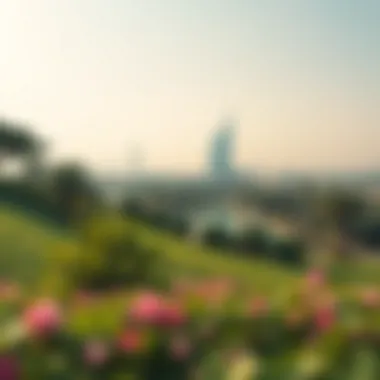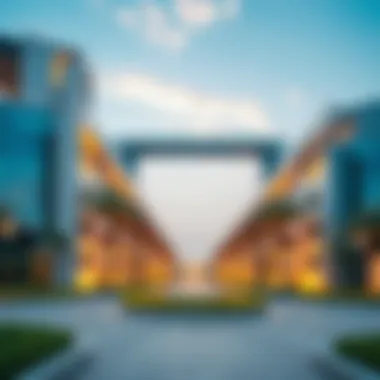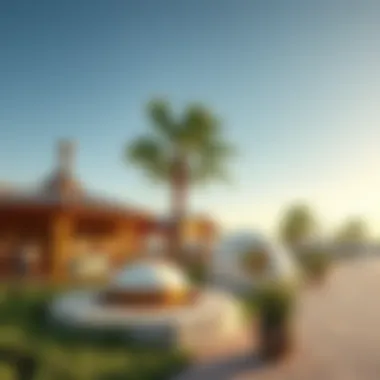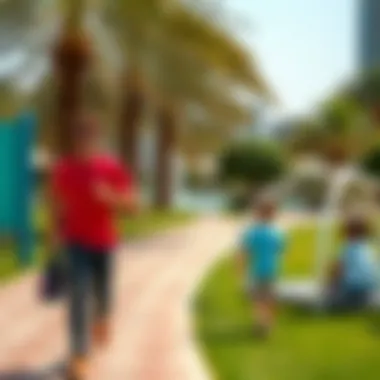Khalifa Park: A Luxurious Oasis in Dubai's Urban Landscape


Intro
Khalifa Park is more than just a green space nestled in the heart of Dubai. It serves as a vital link between the bustling urban life and serene nature, providing both residents and visitors an escape from the concrete jungle. This park reflects Dubai's vision of blending modernity with tradition, an aspect that's crucial in the city's rapid development.
As we embark on this exploration of Khalifa Park, let’s consider the various elements that make it a cornerstone of community interaction and a symbol of cultural significance in this vibrant city. From its architectural features to sustainable practices, the park embodies a commitment to enhancing quality of life within urban settings.
For investors, developers, or simply those intrigued by urban planning, this oasis stands as an example of how public spaces can shape landscapes economically and socially. With insightful analysis, we will dissect the current market trends around Khalifa Park and consider future projections that could impact both its vicinity and the overall real estate market."
Market Trends
Current Market Analysis
Dubai has always been a hotbed for investment, and the real estate scene continues to flourish. Here, Khalifa Park acts as a catalyst for enhancing property values in the surrounding neighborhoods. The park's accessibility and attraction provide increased foot traffic, influencing nearby commercial ventures and residential properties alike.
It’s apparent that the desire for green spaces is growing not just in Dubai but worldwide. Investors are seeing a shift in what prospective homeowners seek. Amenities like parks are no longer optional but essential. Areas adjacent to Khalifa Park have seen a surge in demand, making properties in this vicinity considerably more valuable compared to others lacking similar features.
Future Projections
Looking ahead, the prospects for Khalifa Park and its surroundings are promising. With Dubai's ongoing expansion, new developments are sprouting up, gradually enhancing the landscape. Based on trends, properties near this lush oasis are expected to appreciate in value, sturdy enough to attract diverse demographic groups from expats to locals.
According to studies, urban areas that prioritize greenery often observe a rise in lifestyle quality, leading to increased desirability and real estate prices. Therefore, if you're considering an investment, keep an eye on future expansions that may enhance accessibility to the park and uplift nearby residential areas.
“Investing in areas close to well-maintained parks like Khalifa is not just about a property; it’s about investing in quality of life.”
In summary, Khalifa Park is not just an escape but a strategic focal point as urbanization continues. Those who recognize its significance now will likely reap rewards in the years to come.
Preamble to Khalifa Park
Khalifa Park is not just any green space in the midst of the bustling city of Dubai; it's a carefully crafted sanctuary that blends nature with culture and recreation. This introduction serves as a foundation for understanding its significance, showcasing how it plays a critical role in both the ecological and social fabric of the urban landscape. Engaging with Khalifa Park offers a unique perspective on Dubai's ambitious urban planning and its commitment to fostering an environment that balances modern development with nature.
Historical Context
The story of Khalifa Park dates back to the turn of the millennium when it was inaugurated in 2007, marking a pivotal moment in Dubai's evolution as a global metropolis. Initially known as "Dubai Garden", it was later rebranded in honor of Sheikh Khalifa bin Zayed Al Nahyan, the President of the UAE. This naming symbolizes the close ties between Abu Dhabi and Dubai, emphasizing unity. The park’s development is an embodiment of a shift during the early 2000s, moving towards creating sustainable public spaces in a city characterized by rapid urbanization. Historical records reveal planning stages focused on ecological balance, influenced by regional cultures and heritage, hence making Khalifa Park an ideal reflection of the desert oasis tradition.
Architectural Significance
Architecturally, Khalifa Park is a marvel that marries functional design with aesthetic appeal. Spanning over 64 acres, it boasts intricate landscaping, water features, and walkways that invite exploration. The layout was meticulously crafted to encourage foot traffic, with meandering paths that guide visitors through various themed gardens. Notably, the park's design integrates local flora, delighting both residents and tourists with native plant species. The striking structures within the park, such as the iconic library and cultural center, showcase contemporary design elements that stand in harmony with traditional Arabic architecture. Moreover, the thoughtful incorporation of land and water elements, like reflective ponds and fountains, provides a serene atmosphere, inviting quiet contemplation amidst the city’s hustle.
Role in Dubai's Urban Planning
In the grand scheme of Dubai's urban planning, Khalifa Park holds a crucial role. It is part of a broader strategy to enhance the quality of life for residents while ensuring that green spaces are interspersed within the urban grid. This approach reflects global trends where cities prioritize sustainable living and recreation. By integrating large parks within residential and commercial districts, the city fosters community interaction and a healthier lifestyle. Khalifa Park serves not only as an oasis for relaxation but also as a venue for community events, cultural festivals, and art exhibitions, contributing to social cohesion. As part of Dubai’s Vision 2021, the park symbolizes a commitment to sustainable urban living and is a testament to the city’s ingenuity in preserving nature in an area predominantly known for its towering skyscrapers.
"Khalifa Park is a beacon of community spirit and ecological mindfulness in a city that never sleeps."
Understanding these dimensions of Khalifa Park lays the groundwork for delving into the various features that make it a significant haven in Dubai's urban landscape. The next section will explore the park's key features, examining how they embody the multifaceted nature of this luxurious oasis.
Key Features of Khalifa Park


Khalifa Park blends nature and urban life seamlessly, offering a balance that is quite rare in a city like Dubai. Its key features not only beautify the area but also serve several important functions for both residents and visitors. These features are vital for understanding why the park remains a cherished locale amidst Dubai's rapid development, catering to diverse needs and enhancing the quality of life in the bustling metropolis.
Expansive Green Spaces
One of the park's most prominent characteristics is its expansive green spaces. Spanning over 64 acres, the landscaping is meticulously designed, featuring lawns, botanical gardens, and shaded pathways. This oasis provides a much-needed respite from the concrete jungle surrounding it. With over 1,800 trees and a variety of plant species, it's a place where nature lovers can come to breathe fresh air, enjoy a leisurely stroll, or engage in picnicking with family and friends.
These green areas not only enhance the aesthetic appeal of the park but also serve as vital ecological spaces that support local wildlife. The lush vegetation plays an important role in reducing urban heat, thereby lowering the overall temperature in the area. The appeal of these serene landscapes cannot be understated, as they invite individuals from all walks of life to take a time-out from the hectic pace of urban living.
Cultural and Educational Institutions
Adding to the allure of Khalifa Park are its cultural and educational institutions. Home to the Etihad Museum, the park serves as an educational resource that chronicles the history of the United Arab Emirates, offering insights into its formation and evolution. This institution acts as a bridge connecting residents and visitors to the rich heritage of the region.
Moreover, the park features a children’s garden, designed to stimulate learning through interactive play. It’s here where young minds can explore while being surrounded by nature, which aligns with contemporary educational philosophies emphasizing experiential learning. By fostering knowledge and cultural appreciation in such a picturesque environment, Khalifa Park stands as a beacon of both learning and leisure.
Recreational Amenities
Khalifa Park is not just about relaxation; it caters to the adventurous spirit as well. The park is brimming with recreational amenities that foster community engagement and foster an active lifestyle. A plethora of walking and jogging trails, cycling paths, and dedicated play areas are designed to encourage physical activity among visitors. Large open areas are available for sports such as football, frisbee, and team games, making it a hub for local sports enthusiasts.
Active lifestyle opportunities are complemented by the availability of a high-tech amphitheater, where various cultural events and performances are hosted throughout the year. This space transforms the park into a center of community engagement, making it a primary location for events that bring everyone together.
In summary, the key features of Khalifa Park resonate deeply with the aspirations of a modern urban environment. By providing extensive green spaces, significant cultural institutions, and ample recreational amenities, the park remains a vital asset in Dubai's evolution. Its ability to cater to the diverse needs of the local community further solidifies its position as a luxurious oasis in the heart of a thriving city.
"Khalifa Park stands not just as a park but as a community cornerstone, enriching lives by bringing people together.”
For more insightful details on parks like Khalifa Park, you may consider visiting resources like Wikipedia or Britannica.
Visitor Experience
Understanding the visitor experience at Khalifa Park is vital, as it not only encompasses the immediate enjoyment of its lush landscapes and facilities but also reflects the broader socio-cultural impact on Dubai. The park serves as an escape from the buzzing city life while promoting an engaging outdoor environment. Visitors find themselves immersed in the beauty and tranquility of the park, which highlights the city’s commitment to providing wellbeing through nature.
Access and Connectivity
One of the standout attributes of Khalifa Park is its accessibility. The park is conveniently located near major residential and business areas, ensuring that it remains within reach for many. Public transportation options, including the Dubai Metro and buses, connect the park to various parts of the city effectively. For those who prefer a more personal commute, ample parking facilities are available nearby. Access routes to the park are designed to accommodate pedestrians and cyclists alike, promoting a healthy lifestyle right from the doorstep.
Popular Activities
The diverse activities available at Khalifa Park cater to a wide range of interests, ensuring visitors from all walks of life can find something enjoyable. Here’s a glimpse of what awaits:
- Walking and Jogging Trails: Lined with greenery, these paths offer a perfect setting for casual walks or spirited jogs amidst nature.
- Cultural Events: Throughout the year, the park hosts various cultural events, which showcase local art, music, and history, attracting both tourists and residents alike.
- Children’s Play Areas: Equipped with modern playgrounds, these spaces are designed to spark creativity among younger visitors.
- Botanical Garden: Often overlooked, the botanical garden features numerous plant species, providing an educational experience for those interested in flora.
- Picnic Zones: Designated areas allow families to enjoy picnics while surrounded by lush scenery, making it a favored spot for gatherings.
This array of options not only promotes outdoor activities but also enhances community bonding.
Visitor Demographics
Khalifa Park attracts a diverse group of visitors. From families enjoying a day out to solitary individuals seeking peace, the demographics tell a rich story. Here’s a breakdown:
- Families: A significant portion of visitors consists of families who cherish the recreational amenities.
- Young Adults: This group often frequents Khalifa Park for jogging or attending cultural events.
- Tourists: A considerable number of tourists visit, drawn by the park's reputation as a green oasis amid the urban sprawl.
- Seniors: With its serene environment and facilities like shaded benches, seniors find it a peaceful retreat.


The blend of these demographics enriches the park’s atmosphere, fostering a sense of community and shared enjoyment.
"Khalifa Park is more than just a park; it's where memories are created and the community comes alive."
Through careful design and a myriad of activities, Khalifa Park serves as a vital component of Dubai’s urban living, proving that green spaces can be both luxurious and community-focused. The key elements influencing the visitor experience significantly contribute to the overall appreciation of this urban oasis.
Impact on Local Community
The influence of Khalifa Park on the local community goes beyond mere aesthetics; it plays a crucial role in the social, cultural, and economic fabric of Dubai. This park aims to foster community interaction, promote health, and provide a nurturing habitat for various species, all while enhancing the lifestyle of the residents. Its presence encourages a sense of belonging and pride among the locals, highlighting its significance as a cornerstone in the urban landscape.
Community Engagement Programs
Khalifa Park boasts a variety of community engagement programs that aim to strengthen social ties and promote active participation from residents. These programs often include workshops on sustainability practices, cultural festivals, and educational initiatives that are tailored to involve schools and local organizations. For example, the park regularly organizes environmental education sessions for children, teaching them the importance of conserving natural resources. Such programs have proven to be a hit, drawing families and communities together.
Additionally, initiatives like volunteer days allow residents to partake in park clean-ups or tree planting events, fostering a strong sense of community ownership. These activities not only beautify the park but also instill a sense of responsibility towards the environment, encouraging sustainable habits that can be continued beyond park boundaries.
Long-term Benefits for Residents
The long-term benefits Khalifa Park offers to the residents of Dubai are extensive. Firstly, the park serves as an invaluable recreational resource, providing a green escape from the skyscrapers and hustle of urban life. Regular access to green spaces has been shown to improve mental health, offering residents a place for relaxation and leisure activities. It's not just a pretty place to look at; it provides crucial benefits such as reducing stress and fostering community spirit.
In fine tuning the community infrastructure, Khalifa Park helps increase property values in the surrounding areas. Properties near well-maintained green spaces often command higher market prices, making it not only an appealing residential option but also a smart investment for prospective homebuyers. This effect can often be seen reflected in local real estate trends, demonstrating a direct link between the park's existence and economic uplift.
Integration with Local Businesses
Khalifa Park supports local businesses by generating traffic and creating opportunities for partnerships. Nearby cafes, restaurants, and shops often benefit from the increased footfall, particularly during events hosted at the park. This symbiotic relationship enhances the overall visitor experience while also providing local businesses a platform to thrive.
Furthermore, local vendors are frequently invited to set up stalls during community events, enabling them to showcase their products and services directly to the park's visitors. This not only aids in diversifying the local economy but also encourages the practice of supporting homegrown businesses. The park stands as a conduit for economic development, thereby improving the quality of life for residents in a holistic manner.
Overall, the integration of Khalifa Park into Dubai's urban framework illustrates the genuine efforts toward enhancing quality of life. From community programs to economic benefits, its impact resonates strongly, nurturing a more vibrant and cohesive society.
Sustainability Initiatives
Khalifa Park is not just an oasis for relaxation and recreation, but it also serves as a model for sustainability in the heart of Dubai. Given the rapid urban development in the emirate, the importance of integrating eco-friendly practices into public spaces cannot be overstated. These sustainability initiatives reflect a commitment to preserving the environment while ensuring that luxuries and modern conveniences coexist harmoniously with nature. Understanding these initiatives provides insights into how Dubai is navigating the challenges of urbanization while prioritizing ecological balance.
Eco-friendly Practices
At the core of Khalifa Park's charm lies its steadfast dedication to eco-friendly practices. The park is designed with sustainability in mind, employing various techniques to minimize its environmental impact.
- Water Conservation: A significant aspect of the park’s strategy is its advanced irrigation system, which utilizes reclaimed water for irrigation. This cuts down on the need for fresh water, a valuable resource in the arid landscape of Dubai.
- Plant Selection: The flora chosen for the park features native plants that are better suited for the local climate. These plants require less water and maintenance, which not only supports local biodiversity but also enhances the park's aesthetic.
- Renewable Energy Use: Some energy needs of the park are met through the use of solar panels. This initiative shows a move towards lowering carbon emissions, incorporating renewable sources into the lifestyle of city residents.
Overall, these eco-friendly practices in Khalifa Park underscore a broader commitment to creating public spaces that inspire environmental stewardship.
Conservation Efforts
Conservation efforts at Khalifa Park are multifaceted, targeting both the immediate environment and broader wildlife initiatives. The park plays an essential role in preserving local flora and fauna, which is critical in the face of urban encroachment.
- Wildlife Habitats: Specific zones within the park are designated as wildlife habitats. These areas are carefully protected to promote biodiversity and offer safe retreats for local species, away from city life.
- Educational Programs: Khalifa Park also hosts workshops and programs aimed at educating visitors about the importance of conservation. School groups and families benefit from hands-on activities that spotlight environmental awareness.


"Educational initiatives foster an understanding of ecological responsibilities that can empower the next generation to make informed choices."
By actively engaging the community in these conservation efforts, the park not only preserves the natural environment but also cultivates a sense of stewardship among visitors.
Future Sustainability Plans
Looking ahead, Khalifa Park is not resting on its laurels. There are plans to enhance the sustainability initiatives that have been established, paving the way for a greener future.
- Expanded Green Technology: Future projects include expanding the integration of green technology, such as smart waste management systems that will reduce litter and encourage recycling.
- Additional Biodiversity Projects: There are proposals to implement more biodiversity programs that link the park with surrounding ecosystems, fostering ecological corridors that support species migration and habitat protection.
- Innovative Community Involvement: The park aims to introduce community-led sustainability projects where local residents can contribute practically to conservation efforts, ensuring that the initiatives reflect the needs and desires of the community.
These future sustainability plans highlight Khalifa Park’s ambition not only to remain a luxurious retreat but also to be a beacon of sustainable development amidst Dubai’s urban landscape.
Comparative Analysis
A comparative analysis of Khalifa Park with other parks in Dubai offers valuable insights into the unique characteristics and benefits of this urban oasis. The growth of Dubai as a global city has led to the establishment of multiple parks, each catering to a diverse range of needs and preferences. Understanding how Khalifa Park stacks up against its peers illuminates its role not merely as a recreational facility but as a vital component of Dubai's urban landscape.
Khalifa Park vs Other Parks in Dubai
When pitting Khalifa Park against other notable parks such as Zabeel Park or Safa Park, several factors come into play that make Khalifa Park stand out. For one, its size is considerable; the park stretches over 64 hectares, offering ample space for visitors to unwind. Zabeel Park, while popular, pales in comparison at around 47 hectares. Khalifa Park combines lush greenery with well-developed spaces that include an aquarium and a children's museum, which aren’t typically found in other parks.
Moreover, the aesthetic appeal of Khalifa Park is unmatched. The incorporation of water features, pathways adorned with native plants, and art installations creates a visual experience that captivates visitors. In contrast, some other parks in Dubai focus more on open play areas or sporting facilities, which, although beneficial, do not provide the same immersive environmental experience.
In terms of accessibility, Khalifa Park is ideally located near important urban centers and is easily reachable via public transportation. This is a key consideration for families or tourists who wish to enjoy a day out without the hassle of navigating through congested traffic, unlike some more remote parks.
"A park is not only a space for leisure, but also a reflection of a city's values, aspirations, and commitment to enhancing the quality of life for its residents."
Unique Selling Points
Khalifa Park boasts several unique selling points that contribute to its exceptional status among Dubai's greenery. First and foremost, its integrated cultural resources elevate the visitor experience significantly. The presence of the Dubai Aquarium and the Children’s City enriches family outings, providing educational opportunities alongside leisure. This diversified offering isn't as prevalent in other parks, which may lack cultural or educational attractions.
Secondly, the commitment to sustainability in infrastructure and landscaping sets Khalifa Park apart. Facilities designed with eco-friendly principles, such as rainwater harvesting and solar lighting, promote environmental stewardship, aligning with global sustainability goals.
Additionally, the park's thoughtful design promotes community engagement through various events and programs aimed at fostering social interactions. Community gatherings, outdoor movie nights, and activity days ensure that the park remains a vibrant hub for local residents, keeping the momentum alive.
By comparing Khalifa Park against its counterparts, we gain a more nuanced understanding of what makes this park not only a pleasant destination but an essential piece of Dubai's evolving narrative. The careful planning behind the park’s features and its strategic location undeniably enriches the lives of those who inhabit and visit this bustling city.
The End
The conclusion of this article reinforces the significance of Khalifa Park as more than just a green space amidst Dubai's urban sprawl. This park serves as a vital retreat for those seeking respite from the city's hustle and bustle. Moreover, it encapsulates the essence of sustainable urban living that Dubai is striving for.
Summary of Key Insights
- Cultural Importance: Khalifa Park is not just a park; it is a cultural landmark that fosters community spirit and encourages cultural exchanges.
- Visitor Experience: The array of amenities available ensures that visitors of all ages have enriching experiences, from educational institutions to recreational facilities.
- Sustainability Initiatives: The park's eco-friendly practices set a benchmark for future developments, emphasizing the importance of nature conservation in urban planning.
- Impact on Local Community: The integration of Khalifa Park into the urban landscape significantly enhances the quality of life for local residents, providing them with accessible green spaces while nurturing community ties.
By synthesizing these points, it's clear that Khalifa Park stands as a beacon of how urban spaces can harmoniously integrate nature while promoting well-being and cultural vibrancy.
Future of Khalifa Park
Looking ahead, Khalifa Park is poised for continued growth and enhancement. Future plans may include expanding the park's eco-friendly initiatives, introducing more interactive exhibits and programs aimed at educating the public about sustainability, and further partnerships with local businesses to bolster community engagement.
- Increased Accessibility: With the ongoing development of transportation networks in Dubai, visitors can expect improved access to the park, which will likely enhance its visitor demographic.
- Hybrid Events: As urban spaces evolve, Khalifa Park may play host to hybrid events, combining leisure with culture to attract a more diverse audience.
- Technological Integration: The future might see technology playing a bigger role in visitor experience, with apps designed to guide potential visitors through the park's vast offerings and provide real-time information.
In summary, the future of Khalifa Park as an urban oasis is bright, mirroring Dubai's ambitions for a sustainable and inclusive urban environment. By investing in its continuous development, the park can remain an integral part of the city’s fabric, nurturing harmony between nature and urban lifestyle.



